If you don't have the best memory card for your camera, then you're not going to get the most out of your photoshoots. With so many options for speed, capacity, brand, compatibility, and price available, you might initially feel overwhelmed. However, we've broken down the best memory cards available to show you which ones are best for you.
When you think of a memory card, you'll likely find that the popular SD card format comes to mind. However, if you're using a newer camera, or one of the best professional cameras, then you'll likely need to look for a CFexpress card. However, Compact Flash, microSD and CFast cards are still all in use by some cameras as well.
One of the most obvious ways to differentiate between memory cards is how much storage they have. A 32GB card might be fine for an afternoon wandering around your local wildlife reserve, but videographers looking to shoot all day could get frustrated with having to constantly swap over cards.
However, this isn't the only way to judge what memory card is best, as you'll also need a card with fast read and write speeds. This will not only affect how quickly you can transfer images from the memory card to your computer (or one of the best portable hard drives), but it will also impact the burst mode on your camera. If your memory card isn't fast enough, you'll find that it will lag and struggle to accomplish the blisteringly-fast shooting speeds that someof the latest cameras are capable of.
Read more: How to understand everything written on your memory card
If you're still not quite au fait with all of this technical lingo, then don't worry. We've put together a handy jargon explainer at the bottom of this article to help you find the best memory card for your needs.

Ben is the Imaging Labs Manager, responsible for all the lab testing of cameras and lenses on Digital Camera World. Whether he's in the lab testing the sharpness of new lenses, the resolution of the latest image sensors, the zoom range of monster bridge cameras or even the latest camera phones, Ben is our go-to guy for technical insight. His expertise also extends to computing, with extensive knowledge of the latest laptop and desktop computers, as well as monitors, external storage and memory cards.
The Quick List

If you're a photo enthusiast passionate about your hobby, then you could do worse than picking up the Extreme PRO SDXC card from industry stalwart SanDisk.

This microSD card from a respected brand boasts read/write speeds fast enough for most needs, as well as lots of capacity options. It's good value, too, making it a great all-rounder.
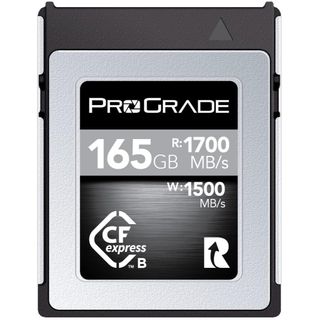
With super-fast speeds across the board (including sustained write speed), this Type B card is a force to be reckoned with.
Read more below...
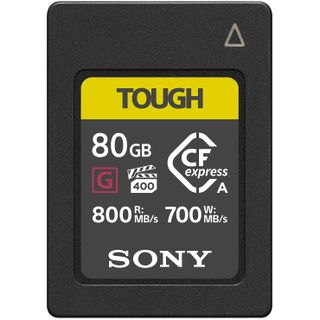
This CFexpress Type A card is the best choice for cameras like the Sony A7 IV, A1, and a7S III making it perfect for creatives or video professionals.

If you're still using CompactFlash with your trusty DSLR, this SanDisk card is both rapid and available in plenty of capacities for stills or video.
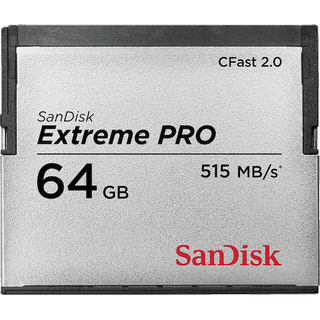
If your main game is filmmaking then this is the card of choice for professional cinema video cameras from the likes of Canon, Arri, and BlackMagic.
The best memory card in 2024
Why you can trust Digital Camera World
SD
The postage stamp-sized SD card is the format used by most digital cameras. SD has largely succeeded CompactFlash, although the latter is still popular in some older pro DSLRs. Most card manufacturers offer ranges that give you a choice of SDHC and SDXC, which both broadly do the same thing, just at slightly differing speeds and capacities. You'll find a more detailed explanation of this below. The best memory card for your needs will depend largely on how you want to balance capacity, speed and cost.

1. SanDisk Extreme PRO SDXC UHS-I
Specifications
Reasons to buy
Reasons to avoid
If you're a photo enthusiast passionate about your hobby, then you could do worse than picking up the Extreme Pro SDXC card from industry stalwart SanDisk. This unassuming card is one of the best SD memory cards you can choose, with capacities ranging from 32GB to a staggering 1TB and an impressive UHS Speed Class 3 rating.
However, the most impressive aspect of the Extreme PRO SDXC card is its write speeds of up to 90MB/s, which allows your camera to handle rapid-fire sequential shooting in both JPEG and RAW with ease. Meanwhile, its rapid 200MB/s read speed is perfect for a refreshingly fast workflow.
Aside from capturing Raw photographs, the data crunching on offer with this memory card also makes it suitable for 4K video capture. In short, this is a great, reliable all-rounder – and its price makes it hard to beat.

Specifications
Reasons to buy
Reasons to avoid
Lexar has long been a go-to card brand for photo enthusiasts, with this pro card being top of the tree for us, deploying UHS-II tech to enable read speeds up to 300MB/s and 260MB/s write speeds. In our testing we recorded respectable 171MB/s read and 255MB/s write speeds - very impressive.
So whether you’re shooting Full HD, 4K video, or high-resolution Raw files, this card is eminently suitable. It never faltered during our review, producing no unexpected interruptions during intensive stills or video recording.
Read the full Lexar Professional Class 10 UHS-II 2000X review
| Lab results | Score | Rating |
|---|---|---|
| Read speed | 171MB/s | ★★★ |
| Write speed | 255MB/s | ★★★★ |
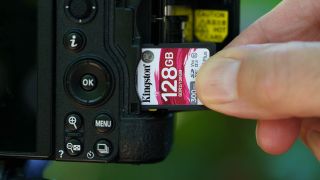
Specifications
Reasons to buy
Reasons to avoid
Kingston's range of memory cards isn't quite as large as some rival brands offer, containing only three SD card series and three microSD series. The Canvas React Plus series is the top tier of Kingston's SD cards and includes 32GB, 64GB, 128GB and 256GB capacity options.
During out extensive testing of the 128GB Kingston Canvas React Plus SD card, we found it to be totally reliable. Even when used in a high-resolution camera like our 45.7MP Nikon Z7 II at its fastest rate (10fps) and when shooting 4K video, the card performed flawlessly. We even tried recording some 8K video and the Canvas React Plus still held its own, though it won't handle the most demanding formats like 8K raw.
Read our full Kingston Canvas React Plus SDXC UHS-II review for more details
| Lab results | Score | Rating |
|---|---|---|
| Read speed | 249MB/s | ★★★★ |
| Write speed | 204MB/s | ★★★★ |

Specifications
Reasons to buy
Reasons to avoid
PNY offers four distinct SD card series, with the X-Pro 90 SDXC UHS-II being the flagship model. It's available in three capacities: 64GB, 128GB and 256GB, with impressive maximum advertised read/write speeds 300MB/s and 280MB/s, respectively.
The card's V90 speed rating signifies that it's capable of a minimum 90MB/s write rate, making it suitable for recording 4K video and even low bit-rate 8K video, along with high-res stills at fast burst shooting speeds.
When we reviewed the X-Pro 90 SDXC UHS-II, we found it produced some of the best figures we've ever recorded from an SDXC card in software benchmarks, and it was super-fast when transferring images to a computer. In our real-world camera testing, the card also demonstrated excellent in-camera burst depths.
Read our full PNY X-Pro 90 SDXC UHS-II review for more details
| Lab results | Score | Rating |
|---|---|---|
| Read speed | 252MB/s | ★★★★ |
| Write speed | 216MB/s | ★★★★ |

Specifications
Reasons to buy
Reasons to avoid
Offering read speeds of up to 300MB/s and write speeds of an equally impressive 260MB/s, this SanDisk UHS-II SD card is a top dog among memory cards. This spec makes it the best memory card for sports, wildlife, and news photographers, shooting bursts of rapid-fire stills, or videographers recording the moment in eye-popping clear 4K resolution.
When we tested the 64GB version of the SanDisk Extreme PRO 300MB/s SDXC UHS-II card, we found it delivered a respectable performance in our software speed test and returned good transfer rates. However, when we inserted the card into our Nikon Z 7II test camera, it couldn't quite match the burst depths we achieved from some rival cards. Many photographers will be unaffected by this, but it could be a deal-breaker for avid sports and action photographers.
Read our full SanDisk Extreme PRO SD UHS-II review for more details
| Lab results | Score | Rating |
|---|---|---|
| Read speed | 252MB/s | ★★★★ |
| Write speed | 207MB/s | ★★★★ |
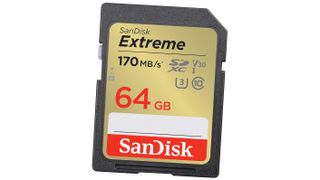
6. SanDisk Extreme SD UHS-I Card
Specifications
Reasons to buy
Reasons to avoid
SanDisk's Extreme range of SD cards come in both standard and Pro versions. Naturally, the Pro cards are slightly more expensive, but even this regular Extreme card features UHS Speed Class 3 compatibility to be able to cope with both Full HD and 4K recording.
A 16GB SanDisk Extreme card can offer data read speeds of up to 180MB/s and write speeds of up to 90MB/s. While these aren't mind-blowing numbers, they're perfectly suitable for most photography needs. Outdoor photographers will be pleased that these cards are also water, shock, temperature and X-ray proof.
If you have no need for blisteringly fast read/write speeds, the SanDisk Extreme range is a great option at reasonable prices.
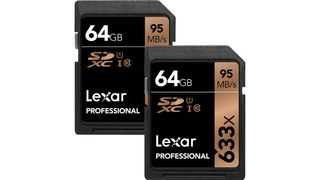
7. Lexar Professional 633x SDHC / SDXC UHS-I
Specifications
Reasons to buy
Reasons to avoid
If you’re shooting high-resolution video, you’re always going to need as much storage space for digital data as you can get. The Lexar Professional 633x SDHC/SDXC UHS-I boasts a huge 1TB capacity option, although read and write rates are a little more modest these days.
This means you have to decide which is more important to you: having the space to store many hours of video, or having the fastest possible transfer speeds between devices.
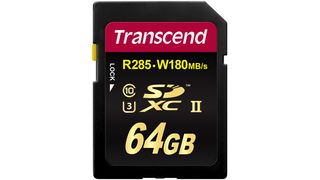
8. Transcend SDXC UHS-II U3
Specifications
Reasons to buy
Reasons to avoid
If you’re shooting raw files you want a card that can handle sequential bursts of the highest quality imagery, as well as a capacity that allows for sufficient storage to avoid having to swap cards every five minutes.
The Transcend SDXC UHS-II U3 is a belter that delivers whether you're shooting raw files or high-resolution video. While the 64GB maximum capacity (the alternative being 32GB) may appear a little modest at first compared with other options here, the performance is anything but, with blisteringly swift read and write times of 285MB/s and 180 MB/s respectively.
Capable of working with a UHS-II compatible DSLR or camcorder, speeds are up to 3x faster than standard UHS-I SD memory cards This card is also shock and X-ray-proof, giving enthusiasts and pros added peace of mind.
microSD
Smaller cameras like action cams use the microSD format, as well as drone, smartphones and tablets. Technically, it's just the same as the SD format, with similar capacities and speed ratings, just in a much smaller form.
See also Best microSD cards

9. Lexar Professional 1066x microSDXC UHS-I Card SILVER Series
Specifications
Reasons to buy
Reasons to avoid
This decent little microSD card is available for a really competitive price, and it boasts respectable 160MB/s read and 120MB/s write speeds, despite it not having the faster UHS-II transfer standard. This card comes in 64GB, 128GB, 256GB and 512GB variations (the latter being ideal if you shoot 4K footage), so you should be able to choose whichever size fits your needs and your budget.

10. Samsung EVO Plus microSDXC
Specifications
Reasons to buy
Reasons to avoid
Available in 32GB, 64GB, 128GB and 256GB capacities, these speedy Class 10 Samsung EVO Plus microSDHC and microSDXC cards come with an SD adapter that allows them to be used in standard SD card cameras just as easily as in a smartphone or tablet.
The smallest-capacity 32GB types won’t break the bank, despite managing read speeds of 100MB/s, although a write speed of 30MB/s is a little more modest. The bright red design also ensures Samsung’s general use offering won’t be easily lost, despite it being the size of a fingernail. Complete with a 10-year limited warranty for peace of mind, the cards are also waterproof, temperature proof, X-ray proof and magnetic proof. You really can’t go wrong with this card.
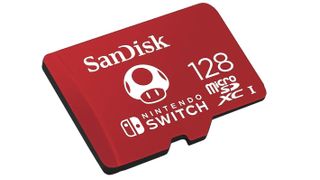
11. SanDisk microSDXC UHS-I card for Nintendo Switch
Specifications
Reasons to buy
Reasons to avoid
It is not just cameras that use microSD cards, of course. And one of the most popular devices to use this memory type at the moment is undoubtedly the Nintendo Switch handheld console, and its baby brother the Nintendo Switch Lite. The slot in memory is not only great for expanding the number of games you carry, but also for taking screenshots and videos of your victories and adventures.
The cards are different colors depending on the capacity - so red with a Nintendo Mushroom icon for 128GB, yellow with a Super Star for the 256GB, and teal green for the 512GB card. You don't need these customized cards, as any microSD card will work in your Switch – but you will earn kudos points for brand loyalty.
• See also Best microSD cards
CFexpress Type B
CFexpress is rapidly becoming the memory card format of choice for high-end stills and video cameras. Evolving from the XQD card format, CFexpress Type B cards share the same outer design as XQD cards, but pack faster memory inside, making them some of the fastest memory cards available today. Almost all cameras that originally supported XQD cards have now been firmware-updated to also work with CFexpress Type B cards, so cameras like the Nikon Z6 and Z7 are no longer restricted to XQD cards alone.
More recently, Sony muddied the CFexpress waters by bring to market CFexpress Type A cards. This CFexpress card variant is physically smaller than the Type B standard, and therefore you can't use a Type A card in a camera designed for XQD/CFexpress Type B cards. You wouldn't really want to though, as the drawback of CFexpress Type A's compactness is a reduction in read/write speed, compared to Type B cards. Only a handful of Sony cameras utilize CFexpress Type A cards, most notably the Sony A7 IV, A1 and a7S III.
• See also Best CFexpress cards

Specifications
Reasons to buy
Reasons to avoid
ProGrade Digital played a major part in bringing the first Type B cards to market, and its experience shows in this highly capable Cobalt offering. Peak 1700MB/s read and 1500MB/s write rates may be a little slower than some competitors, but they're still easily fast enough. However where this card truly shines is its outstanding 1400MB/s minimum sustained write rate, which makes this card ideal for 4K and even 8K video recording that demands extended periods of high-speed data transfer.
Read our full ProGRade Digital CFexpress Type B Cobalt review for more details
| Lab results | Score | Rating |
|---|---|---|
| Read speed | 858MB/s (USB bottlenecked) | ★★★ |
| Write speed | 900MB/s (USB bottlenecked) | ★★★ |
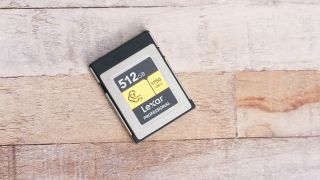
Specifications
Reasons to buy
Lexar's GOLD series of CFexpress cards can be had in 128GB up to 2TB capacities. The 128GB, 256GB and 512GB cards boast 1750MB/s read and 1500MB/s write speeds, while the 1TB and 2TB options manage to increase read speed to a whopping 1900MB/s.
We tested the first generation of GOLD series cards, which topped out at a 1000MB/s write speed, but even this is fast enough to facilitate 8K RAW recording. We also managed to capture a respectable 146 Fine-quality Jpegs at 10fps, and 46 14-bit compressed raw files in around 5 seconds when testing the card in our Nikon Z 7II - exceeding Nikon's buffer depth claims for this camera. The Lexar card was also able to record 8K ProRes video at 30p when shooting with a Nikon Z9 - impressive stuff, especially considering the current generation of Lexar GOLD Type B cards are now capable of 50% faster write speeds.
Read our full Lexar Professional CFexpress Type B Card review for more details
| Lab results | Score | Rating |
|---|---|---|
| Read speed | 908MB/s (USB bottlenecked) | ★★★ |
| Write speed | 870MB/s (USB bottlenecked) | ★★★ |
CFexpress Type A
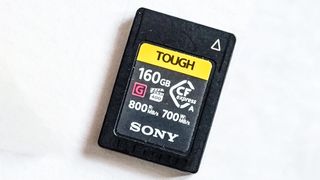
14. Sony Tough CFexpress Type A Memory Card
Specifications
Reasons to buy
Reasons to avoid
CFexpress cards can now be bought in two variants: Type A, and Type B. The latter is far more common and supported by loads more cameras. Both types are based around the same technology, but differ in the amount of PCIe data transfer lanes available. The upshot is Type A cards have a theoretical maximum 1000MB/s data bandwidth, whereas Type B cards can reach up to 2000MB/s. So why is Sony backing the slowest 1000MB/s Type A CFexpress standard when faster Type B cards are already available? It all comes down to compactness. Where a CFexpress Type B card measures 38.5 x 29.8 x 3.8mm, a Type A card is considerably smaller at 28 x 20 x 2.8mm. To put this in perspective, that's even smaller in length and width than a standard SD card.
With read/write rates of 800MB/s and 700MB/s respectively, Sony's Tough CFexpress Type A cards may be a lot slower than most Type B cards, but it's still very fast.
ProGrade Digital also has a 160GB Type A card you can buy, but it's not as readily available as this Sony equivalent, and is only marginally cheaper. Delkin has Type A cards coming soon though, so hopefully prices will start to fall further.
CompactFlash
There are still lots of cameras around that use the Compact Flash format, and it gets plenty of support from memory card makers. The new and upcoming formats for pro cameras are XQD, CFexpress and CFast (all listed further down), but the Compact Flash memory card format looks like it will be around for a while yet.

15. SanDisk Extreme PRO CompactFlash
Specifications
Reasons to buy
Reasons to avoid
CompactFlash may be old school, but there’s nothing nostalgic about the SanDisk Extreme PRO CompactFlash’s 160MB/s read speed. It's also physically large by current memory card standards, but that doesn't mean CompactFlash can't pack enough capacity and speed to satisfy today’s DSLR users.
The SanDisk range offers capacities from a useful 16GB, up to 256GB, so you don’t have to keep swapping cards in the heat of the action. A write speed of up to 140MB/s at maximum 256GB capacity also impresses (and it's an even faster 150MB/s for the 128GB and lower capacities), making it eminently suitable for Full HD video capture. Its minimum sustained write speed of 65MB/s is even class-leading.
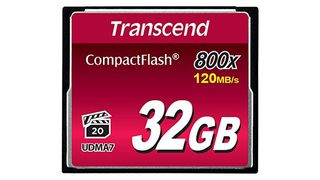
16. Transcend 800x CompactFlash
Specifications
Reasons to buy
Reasons to avoid
Taiwanese company Transcend is another long-term player in the memory card market – and still makes many low-capacity cards, meaning they’re accessible to those on a tight budget.
However, even the higher capacity offerings – such as this CompactFlash 800x series – are hardly expensive for what’s on offer. Capacities run from a standard 32GB up to 256GB. Specification is also impressive for a budget card, with read speeds of up to 120MB/s and write speeds of 60 MB/s, although actual performance, of course, is affected by camera hardware and software. Durable and reliable, there’s even a built-in error-correcting code to detect and correct any transfer errors.
CFast
CFast is a high-speed memory card that looks very similar to CompactFlash. The CFast format is used mostly by high-end video equipment, such as professional cinema video cameras from Canon, Arri and BlackMagic. In terms of stills cameras, this type of card is currently only used in the Canon EOS 1-D X Mark II and Hasselblad H6D-100C. Here are the best CFast cards on the market right now:

17. SanDisk Extreme PRO CFast 2.0
Specifications
Reasons to buy
Reasons to avoid
Lightning fast transfer speeds make CFast perfectly suited to 4K video shooting. SanDisk are the ones to watch in this format, and this most-recent version of its CFast card offers a staggering write speed of 525Mb/s, along with an admirable 400 Mb/s read speed.

18. Lexar 64GB 3500x CFast 2.0
Specifications
Reasons to buy
Reasons to avoid
If you're often working with high quality 4K video, ProRes video, or RAW photos from cameras such as the Canon EOS-1DX Mark II, then you'll know the value of a card that can keep up with what you're shooting.
Luckily, the Lexar 64GB 3500x CFast 2.0 card is with you every step of the way. With a write speed of up to 445MB/s, this Lexar CFast card can help you capture cinema-grade video with ease – while a 525MB/s read speed will dramatically accelerate your post-production workflow.
How to choose
The best memory cards demystified
It's worth remembering that, despite the wide variety of memory card formats, you don't actually need to worry about what type you should use. This is because this decision will have already been made for you by the camera manufacturers. This means that you're not going to be able to use a CFexpress card in a camera with a microSD card slot! However, it's still worth knowing what the benefits and drawbacks of each memory card format are.
SD
While SD cards might immediately come to mind when you think of memory cards, standard SD (Secure Digital) cards are actually no longer manufactured. This is because the technology has moved onto SDHC and SDXC cards, which are readily available. If you have some old SD cards knocking around, you can still use them in newer cameras that have the SD card format, but don't expect the same performance or capabilities offered by newer memory card generations.
SDHC
As an upgrade to the standard SD card, SDHC (Secure Digital Extended Capacity) cards offer memory capacities between 4GB and 32GB. This makes them great for everyday use and entry-level users who don't have large storage capacity needs.
SDXC
You'll find SDXC (Secure Digital Extended Capacity) cards with capacities of 64GB and over. Designed for cameras with large sensors, lots of megapixels, 4K video and other data-intensive applications, serious photographers and videographers will want to choose an SDXC card over SDHC. However, don't forget to check the read and write speeds to ensure you get the performance you need. To get a better understanding of these, read our article on understanding everything written on your memory card
microSDHC and microSDXC
microSDHC and microSDXC cards will offer a similar performance to their larger SDHC and SDXC siblings. However, they're around a third of the size and can be used in the best camera phones and best action cameras.
CompactFlash
CompactFlash used to be the preferred format for higher-end DSLRs. However, with the improved performance of SDHC and SDXC cards (and the introduction of newer memory card formats as well), this memory card format is growing more rare.
CFast cards
While CFast cards look similar in size and shape to CompactFlash cards, they're not compatible (so don't try to jam one in your old DSLR!). This new-generation high-speed memory card format will be found in professional stills and video cameras.
XQD cards
We wouldn't be surprised if you hadn't heard of XQ cards, as they're a little more niche than the memory card formats listed above. At the moment, they're only compatible with selected Sony camcorders and some Nikon DSLR cameras. It doesn't look likely that more cameras will join this format in the future, as it's now been pretty much superseded by CFexpress. However, XQD cards offer great performance for high-speed shooting and video recording.
CFexpress cards
As an evolution of the XQD format, CFexpress is one of the best memory card formats around. However, it's currently only available with a limited number of high end cameras (mostly from Canon, Nikon and Panasonic). However, it's worth noting that the release of the Sony A7S III brought a somewhat confusing split into two different variants of CFexpress cards. Up until this point, all CFexpress-compatible cameras used CFexpress Type B cards (yes, 'B' does come before 'A' in this case!). Meanwhile, CFexpress Type A cards are smaller and slower. Crucially, Type B and Type A cards aren't interchangeable, so a camera such as the Nikon Z7 won't be able to accept a CFexpress Type A card.
Read more: How to understand everything written on your memory card
How we test
Where possible, at DCW we test memory cards in the field as well as subjecting them to benchmarking tests in order to verify a manufacturer's speed claims. We will set our host camera to its fastest burst shooting speed and highest video quality in order to see how a memory card handles the toughest possible stills and video scenarios. Our preferred memory benchmarking apps are Blackmagic Design Disk Speed Test and CrystalDiskMark, which give us a good numerical indication of the maximum read and write speeds that a card is capable of. We then weigh the performance results against a card's asking price to determine whether it represents good value.
Find out more about how we test and review on Digital Camera World.




